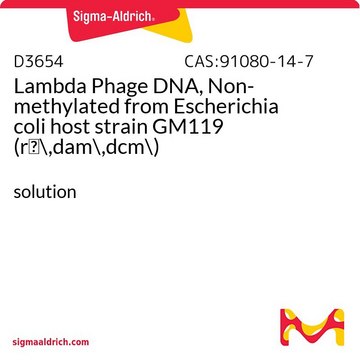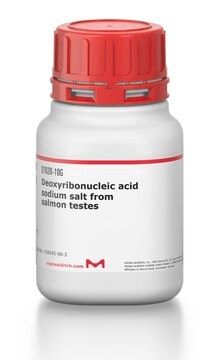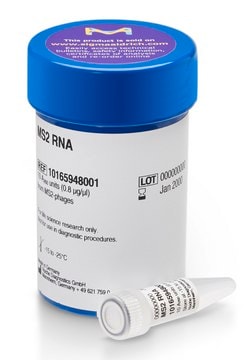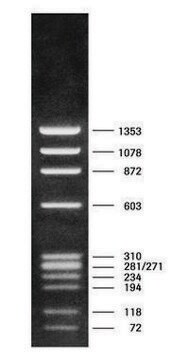10745782001
Roche
DNA, lambda
from bacteriophage lambda cl857 Sam 7
Sinónimos:
lambda dna
Iniciar sesiónpara Ver la Fijación de precios por contrato y de la organización
About This Item
Código UNSPSC:
41106310
Productos recomendados
Nivel de calidad
Formulario
solution
mol peso
32,300 kDa
envase
pkg of 1 mL
fabricante / nombre comercial
Roche
condiciones de almacenamiento
avoid repeated freeze/thaw cycles
concentración
250 μg/mL
impurezas
RNA, none detected
nuclease, none detected
color
colorless
solubilidad
water: miscible
Condiciones de envío
dry ice
temp. de almacenamiento
−20°C (−15°C to −25°C)
Descripción general
The DNA of bacteriophage lambda contains 48,502 nucleotide pairs forming a linear duplex. The 5′ ends of this DNA molecule have self-complementary single-stranded protrusions of 12 nucleotides that can anneal to form circles. Upon entry into the host cell, the DNA circularizes in the presence of DNA ligase. Many such circles are generated during the early lytic infection. At a later stage in replication, these individual circles/rings are converted to linear concatemers by a process called rolling-circle replication. The linear concatemers are cleaved during packaging to form monomeric chromosomal units by the enzyme DNA terminase.
Aplicación
DNA, lambda has been used to spike peripheral blood leukocytes (PBL) before genomic DNA isolation. It has also been used in the preparation of biotinylated double-stranded DNA (dsDNA) substrate.
Calidad
The DNA shows the typical cleavage pattern for wild type λDNA in gel electrophoresis after cleavage with restriction endonucleases EcoR I and Hind III.
Secuencia
Chain Length 48,502 bp
Forma física
Solution, 250 μg/ml, in 10 mM Tris-HCl, 1 mM EDTA, pH 8.0, ready-to-use
Almacenamiento y estabilidad
Store at -15 to -25°C until use; once thawed, store at 2-8 °C.
Otras notas
For life science research only. Not for use in diagnostic procedures.
Código de clase de almacenamiento
12 - Non Combustible Liquids
Clase de riesgo para el agua (WGK)
nwg
Punto de inflamabilidad (°F)
No data available
Punto de inflamabilidad (°C)
No data available
Elija entre una de las versiones más recientes:
¿Ya tiene este producto?
Encuentre la documentación para los productos que ha comprado recientemente en la Biblioteca de documentos.
Los clientes también vieron
Bacteriophage lambda DNA: the beginning of the end.
A Becker et al.
Journal of bacteriology, 172(6), 2819-2824 (1990-06-01)
Isolation of high quality DNA and RNA from leaves of the carnivorous plant Drosera rotundifolia.
Bekesiova I, et al.
Plant Molecular Biology Reporter, 17, 269-277 (1999)
Rachel Howard-Till et al.
BioTechniques, 70(2), 120-125 (2020-12-15)
Genetic characterization of wild and cultivated plants provides valuable knowledge for conservation and agriculture. DNA sequencing technologies are improving, and costs are dropping. Yet analysis of many species is hindered because they grow in regions that lack infrastructure for advanced
Darren Yang et al.
Nature communications, 7, 11026-11026 (2016-03-18)
We present a miniature centrifuge force microscope (CFM) that repurposes a benchtop centrifuge for high-throughput single-molecule experiments with high-resolution particle tracking, a large force range, temperature control and simple push-button operation. Incorporating DNA nanoswitches to enable repeated interrogation by force
Michael R Wasserman et al.
Cell, 178(3), 600-611 (2019-07-28)
The eukaryotic replicative helicase CMG is a closed ring around double-stranded (ds)DNA at origins yet must transition to single-stranded (ss)DNA for helicase action. CMG must also handle repair intermediates, such as reversed forks that lack ssDNA. Here, using correlative single-molecule
Nuestro equipo de científicos tiene experiencia en todas las áreas de investigación: Ciencias de la vida, Ciencia de los materiales, Síntesis química, Cromatografía, Analítica y muchas otras.
Póngase en contacto con el Servicio técnico








